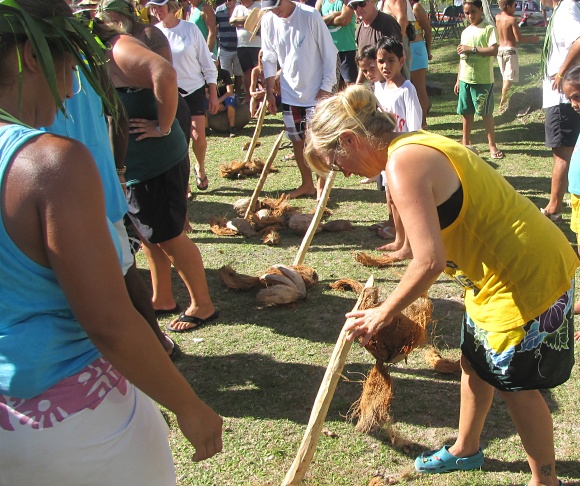Going Coconuts
/Put de lime in de coconut? I've got a loverly bunch of coconuts? Loco in the coco! “You drive me coconuts!”. The word coconut was brought to us compliments of 16th-century Spanish explorers, who saw them for the first time and thought they resembled human heads and faces and appropriately named them “coco” (head). Somewhere along the line, “nut” was added.
There have been times when looking at one more coconut would have put us over the edge. On some islands in the South Pacific, coconuts are the sole choice for a drink selection. Don't get me wrong, I love the smell of coconut in my shampoo and bath soap. Pina coladas rate right up there as my favorite “frou-frou” drink. But when the iced tea, beer and lemonade are gone and you haven't seen a Coke in months and tap water just doesn't cut it, sometimes coconut water is all there is and it gets old fast.
What you see in the grocery stores in the USA is not what you get in the South Pacific islands from the coconut palms. Getting to the coconut meat is a labor-intensive, three-layered process. First of all, a coconut is a drupe, not a nut. I was not all that familiar with “drupes”, mind you, but it seems it's the botanical term for stone fruit like peaches, plums and … coconuts. What you see in the grocery store is just the drupe or inner “stone” itself. In actuality, the outer thick green skin has to be scored and sliced off … usually with a machete. The locals make it look easy, but after much practice, David still had a hard time with this process though he did manage to keep all of his fingers intact and, for that, there is much to be said.
After the thick green skin, comes the husk. We participated in a coconut husking contest in Polynesia and quite honestly, we were not very good at it. This, too, takes practice and some elbow grease. The locals have a specialized tool for coconut husking … a sharp pointed stick protruding from the ground.
If you're just after the coconut water, you can just slice a chunk of the green skin off and punch a hole and sip away. If you want the white meat to eat or to make coconut milk, it definitely takes some effort.
Unlike us and most cruisers who drink the water and perhaps eat the white, sweet, chewy flesh, the islanders use the entire coconut. When dried, the flesh is called copra and it's a major industry on some islands. The oil and milk are used most commonly for cooking. The oil is also used in making soaps and cosmetics. They use the husk and leaves for utensils, jewelry, decoration and fuel. It's typical to drink kava from a half of a coconut shell. And let's not forget coconut bras!
Our son, Brennan, was fascinated with those coconut head figures that you see in seedy souvenir shops and he had quite the collection of them. Wonder what ever happened to them? Truth be told, we still have a pirate head aboard!








